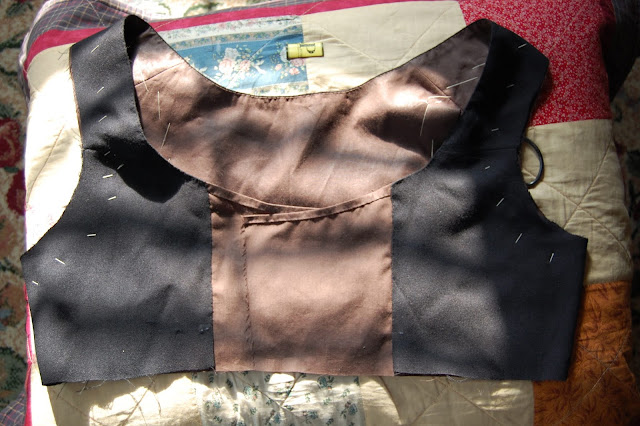 |
| Extant bodice c. 1800 |
An important part of the exhibit is the clothing our interpreters wear during tours. We want to give visitors an idea of the different types of clothing, fabric, and accessories worn during the mourning process by men, women, and children. The material culture of public displays of mourning is very different in the early 1800s compared to our current practices.
The mourning dress I have worn for several years is lovely dull black silk that drapes like a dream but it's back closing with drawstring ties at the waist and neck. This type of dress is exceedingly difficult for me to finish dressing since I'm not double-jointed or as limber as I used to be. There are also times when there are no other interpreters available to help. This is a real problem when there is a group of visitors waiting for a tour and the docent (me) can't get dressed (the struggle is real, people). Besides my silk gown is starting to show it's age and it's time for something new.
 |
| In this photo, I'm wearing my silk dress during a past Mourning Col. Stephenson exhibit. |
In truth, I've wanted to make a new mourning dress for a while but just couldn't decide exactly what I wanted it to look like. Most important it needed to be front closing and adjustable. I also wanted it made out of bombazine. Several bolts of bombazine were purchased by Col. Stepheson's widow, Lucy, as she outfitted her family following his death. This fabric was a mixture of wool and silk typically used to create mourning clothes worn during deep mourning. Unfortunately, bombazine is no longer made so wool crepe (another common mourning fabric very similar to bombazine) would have to suffice. The only thing left to figure out was what pattern to use.
 Last year, I made a dress for my daughter using Laughing Moon #126 Ladies Round and Trained Gown with High Stomacher Front, c. 1800-1810. The dates of this dress are earlier than those interpreted at Stephenson House (1820-1825) but it's an easy pattern to work with as well as perfect for my needs (front closing and adjustable). It is also very similar to dresses depicted by Anna Maria Von Phul in her paintings of our area (St. Louis, MO, and Edwardsville, IL) in the late 18-teens. It's a perfect dress pattern to use as a jumping-off point for this project.
Last year, I made a dress for my daughter using Laughing Moon #126 Ladies Round and Trained Gown with High Stomacher Front, c. 1800-1810. The dates of this dress are earlier than those interpreted at Stephenson House (1820-1825) but it's an easy pattern to work with as well as perfect for my needs (front closing and adjustable). It is also very similar to dresses depicted by Anna Maria Von Phul in her paintings of our area (St. Louis, MO, and Edwardsville, IL) in the late 18-teens. It's a perfect dress pattern to use as a jumping-off point for this project.The internet offered some inspiration but one extant garment, in particular, kept pulling me back. The bodice was the only part of the dress to survive and was sold on eBay as a study garment. The lace around the neckline is simple and elegant plus the bodice is very similar to the LM pattern. I tend to gravitate to simple details since my period garments need to be easy to work in but also a style Lucy Stephenson may have worn. This remanent would be my inspiration.
 |
| This bodice was sold on eBay as a study garment. The only information I was able to find said "Original Empire Period Ball Gown Bodice, c. 1800 for study". |
 |
| This bib appears to be attached to the right side of the bodice. Obviously, the snap was added at a later date. My bib will be attached to the front skirt panel, not the bodice. |
Let the Sewing Begin!!
Yesterday was spent copying the pattern pieces needed for my size. I never cut my actual paper patterns but trace the pieces onto pattern fabric. This allows me to use all the sizes of a pattern more than once without destroying it for one project. This step took most of my afternoon and evening but it was totally worth it.
 |
| The pattern pieces for the bodice are ready to go. |
My mockup went together really quick. It fit perfectly without any adjustments. That NEVER happens to me...EVER!. Usually, something has to be changed or tweaked but not today. The sewing gods were smiling on me.
The fabrics were already in my possession as well. I had already purchased several yards of wool crepe and the polished cotton is a standard item in my fabric stash, so I jumped right in and started putting the bodice together. This is my favorite part of creating a period garment; construction. I love it when everything falls into place.
 |
| The lining is all sewn together. I used brown polished cotton similar to what I believe the eBay study garment used. |
 |
| The front edge of the outer bodice is folded under 1/4" in preparation of it being attached to the lining in a later step. It's hard to see it clearly in the photo because of the dark color. |
 |
| Step one of the prick-stitch |
 |
| Step two of the prick-stitch |
 |
| Prick-stitching as seen from the inside after several stitches. |
 |
| How the finished prick-stitching looks from the right side of the bodice. |
To be continued.....
Other posts related to this project
Making an early 19th century mourning dress: The Skirt
Making an early 19th century mouning dress: Skirt, Bodice, and Bib
Making an early 19th century mouning dress: Sleeves









